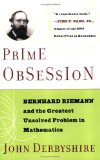Prime Obsession: Bernhard Riemann and the Greatest Unsolved Problem in Mathematics is a book about the Riemann Hypothesis, posed by Bernhard Riemann in 1859. As the book title says, it is one of the greatest unsettled mathematical conjectures remaining today. It is among David Hilbert's list of twenty-three mathematical problems and one of the seven millennium problems presented by the Clay Mathematics Institute.
The Riemann Hypothesis concerns the zeros of the Riemann zeta function,
(actually, the right-hand side is only well-defined for , and is an analytical continuation of this infinite series). The zeta function is defined for all complex numbers and has the so-called trivial zeros along the real line. The Riemann Hypothesis says: All non-trivial zeros of the Riemann Zeta function has real part . Billions of non-trivial zeros with real part have been found computationally, but it remains to prove whether this is true for them all.
The Riemann zeta function is intimately linked to primes through the Euler product formula,
which the book refers to as the Golden Key. Proving the Riemann Hypothesis could provide important insight into the distribution of primes.
It could be called a popular math book, meaning that it is a narrative and the math is not too advanced. The subject of the Riemann Hypothesis is obviously very advanced, since no one has been able to tackle this problem for more than 250 years. So the author undertook a big task when writing this book, and he did a good job. But it also means, of course, that many mathematical aspects are left unexplained. Especially towards the end of the book. But it had to be so, given the book's objective.
The even-numbered chapters attempt to build the mathematical foundatation necessary to understand the rest of the book. Topics such as infinite series, convergence, prime numbers and complex functions are treated. The author claims that the book is aimed towards readers who “finished high school math satisfactorily and perhaps went on to a couple of college courses”. This is probably true. The odd-numbered chapters contain historical and biographical background material.
This is a good book. While describing the history and mathematics of the Riemann Hypothesis, the author manages to make to story interesting from beginning to end. The break-throughs, the set-backs, the key persons, the seemingly random events that suddenly made this unsolved problem interesting again.
I would recommend it to anyone interested in mathematics and who has some basic mathematical knowledge.
If I were to awaken after having slept for a thousand years, my first question would be: Has the Riemann hypothesis been proven? — David Hilbert (Quoted in Mathematical Mysteries: The Beauty and Magic of Numbers)
Book facts:
- Author: John Derbyshire.
- Book title: Prime Obsession.
- Publication year: 2004.
- Publisher: Plume Books.
- ISBN: Paperback 0452285259.
